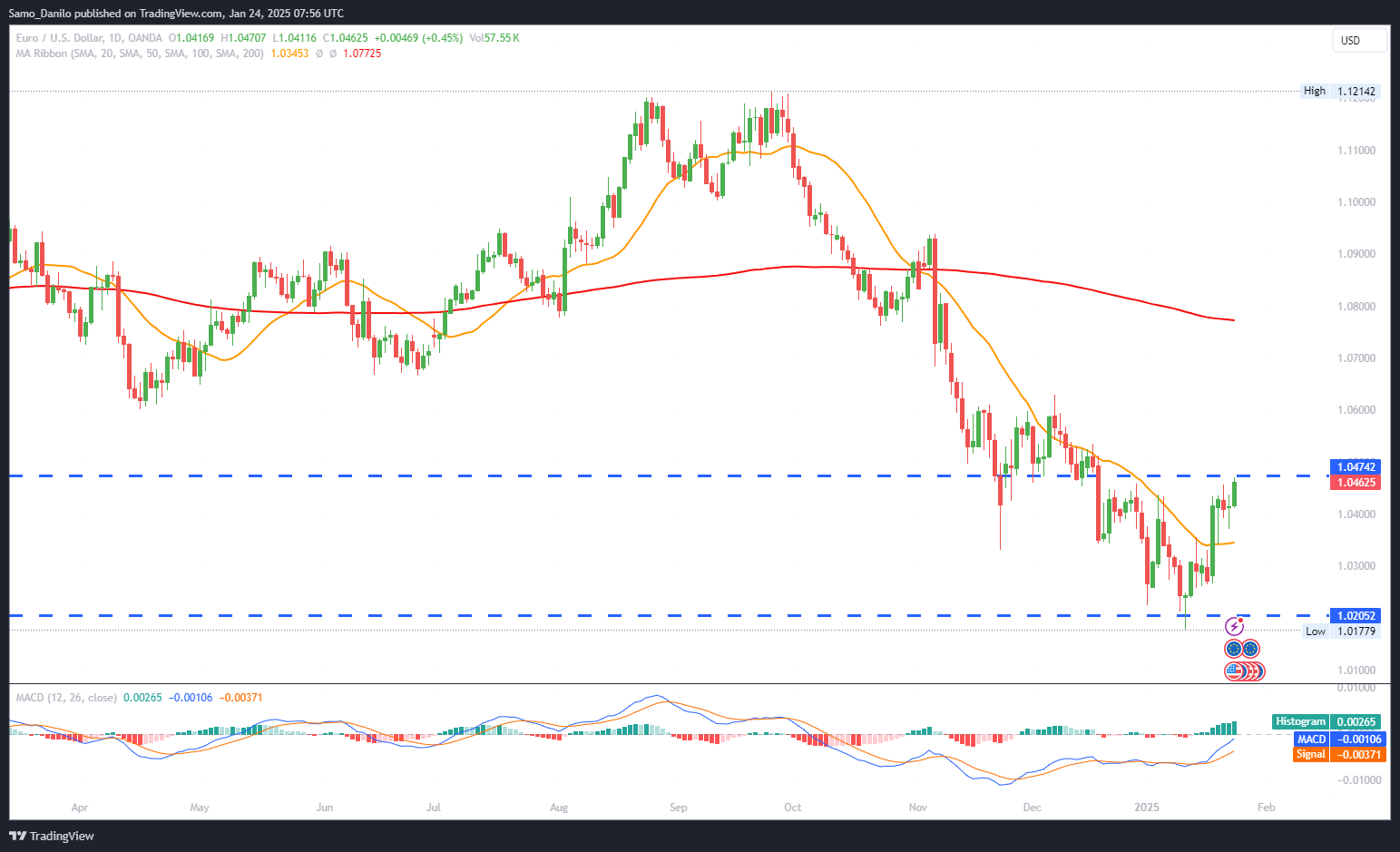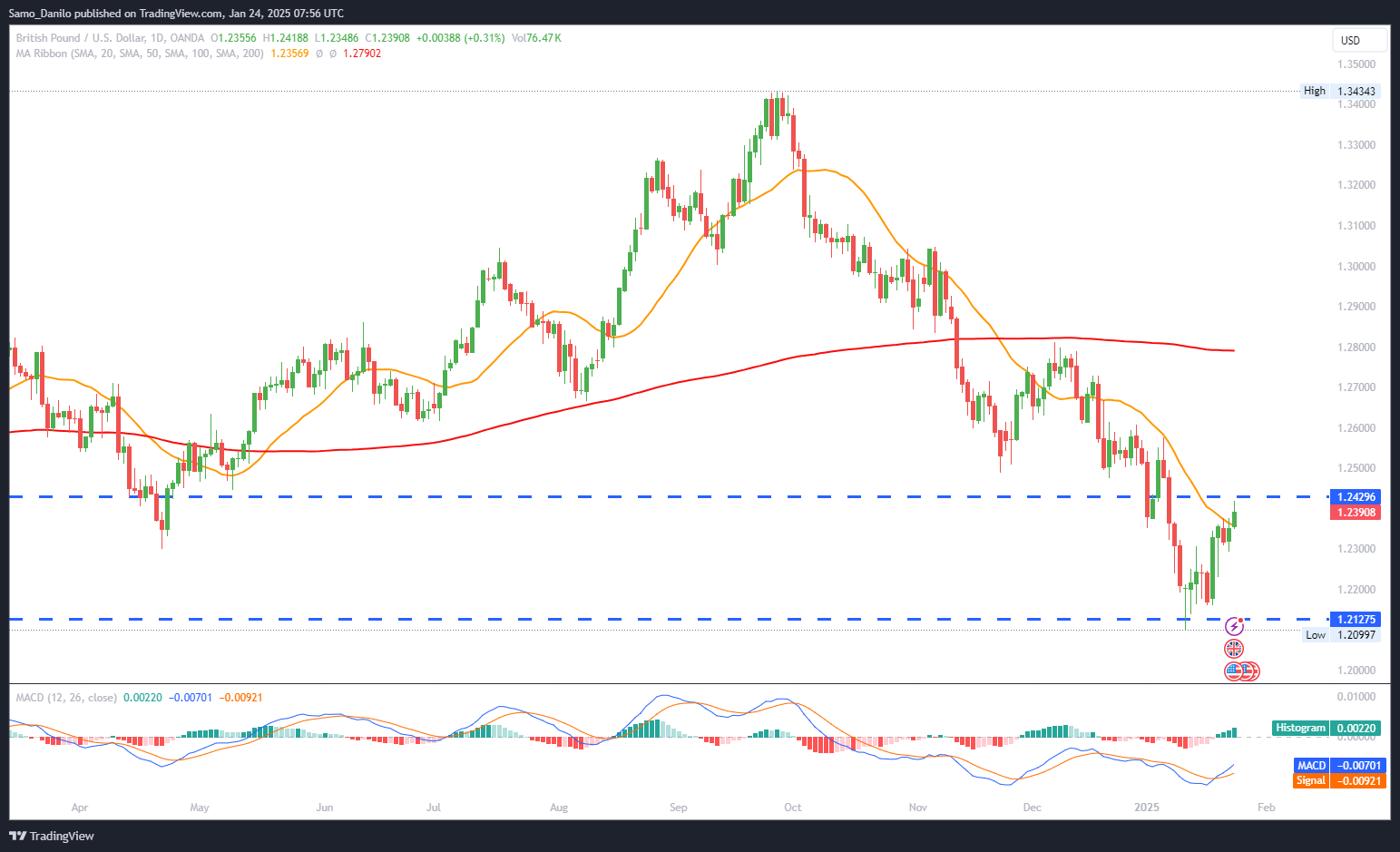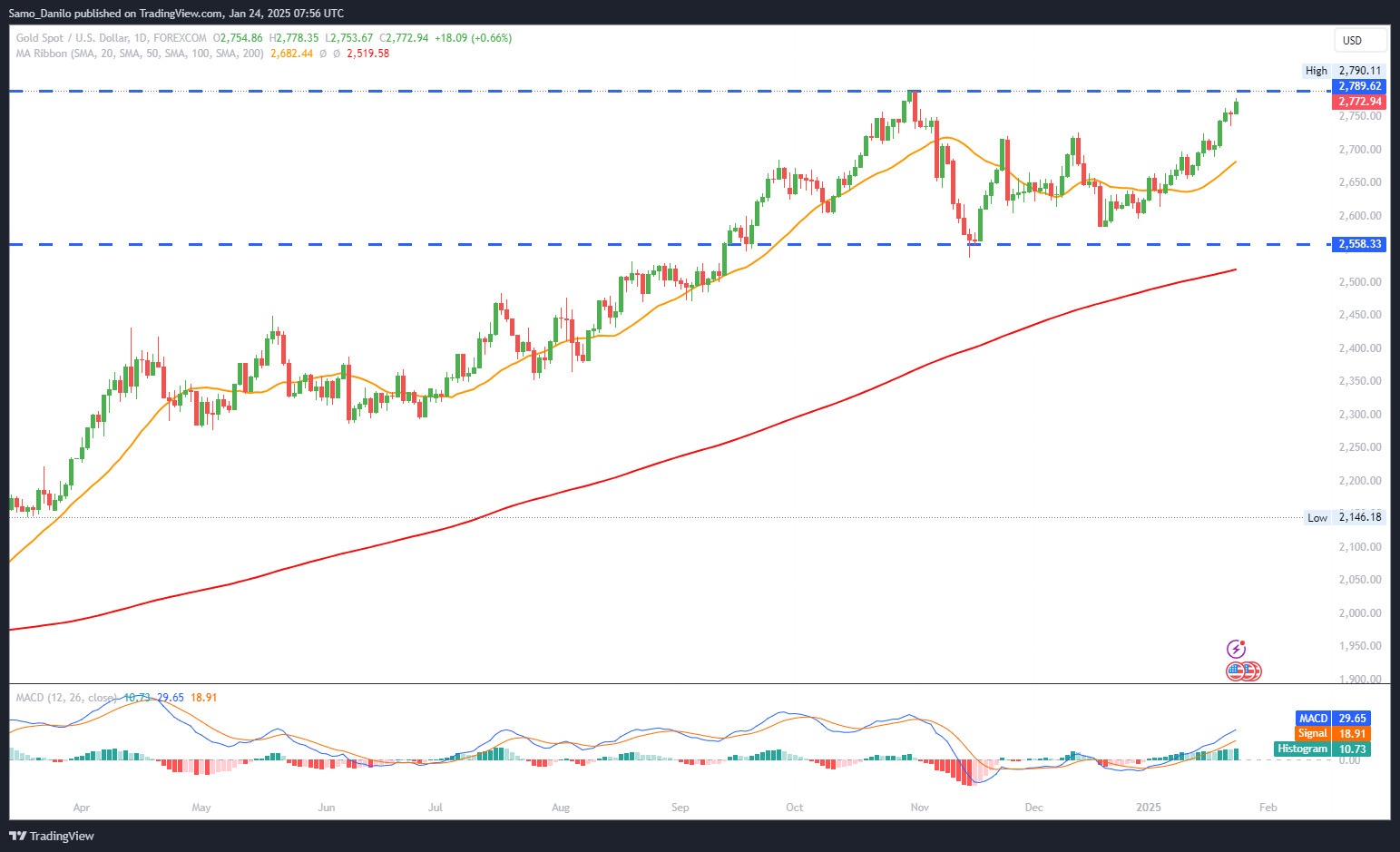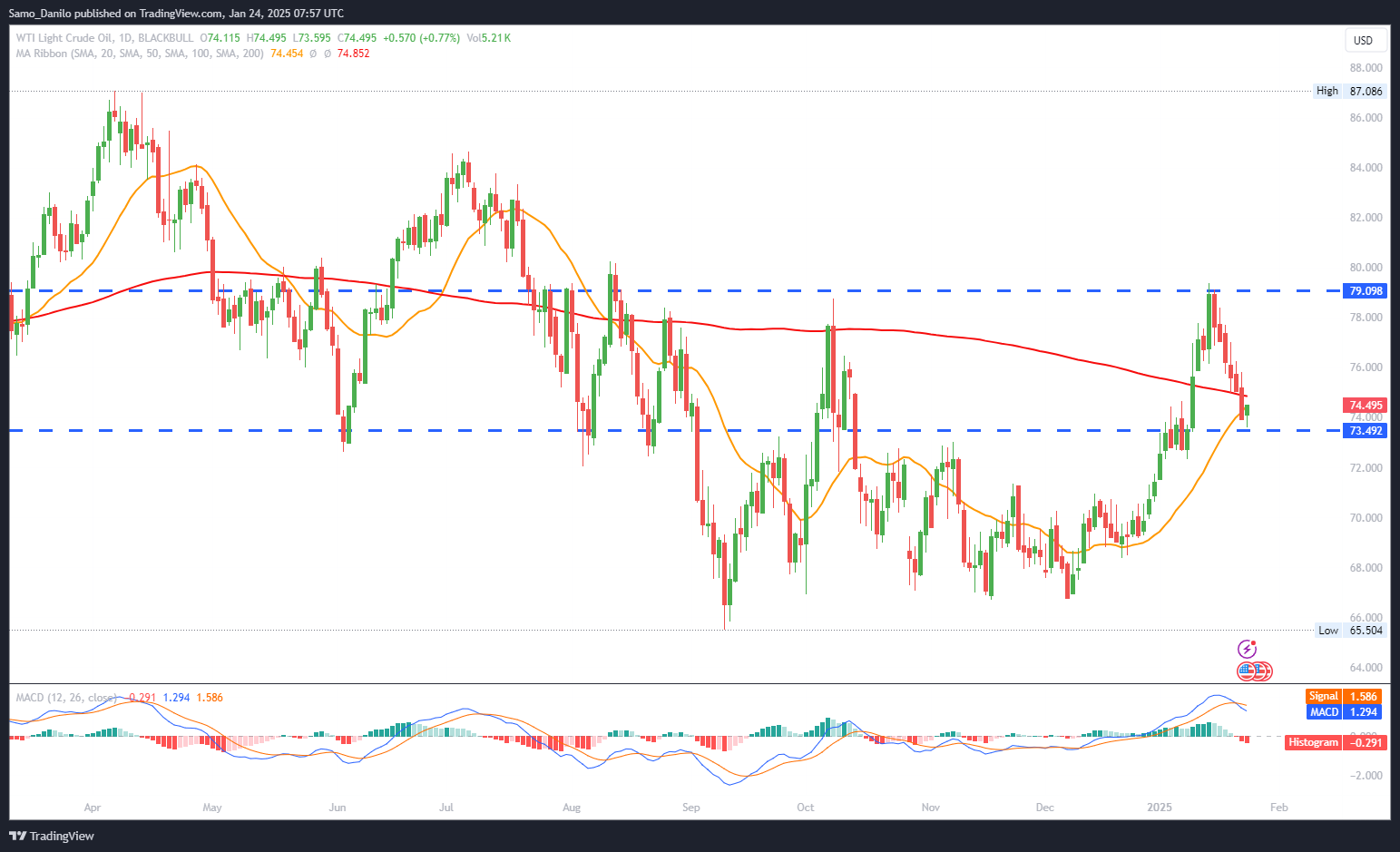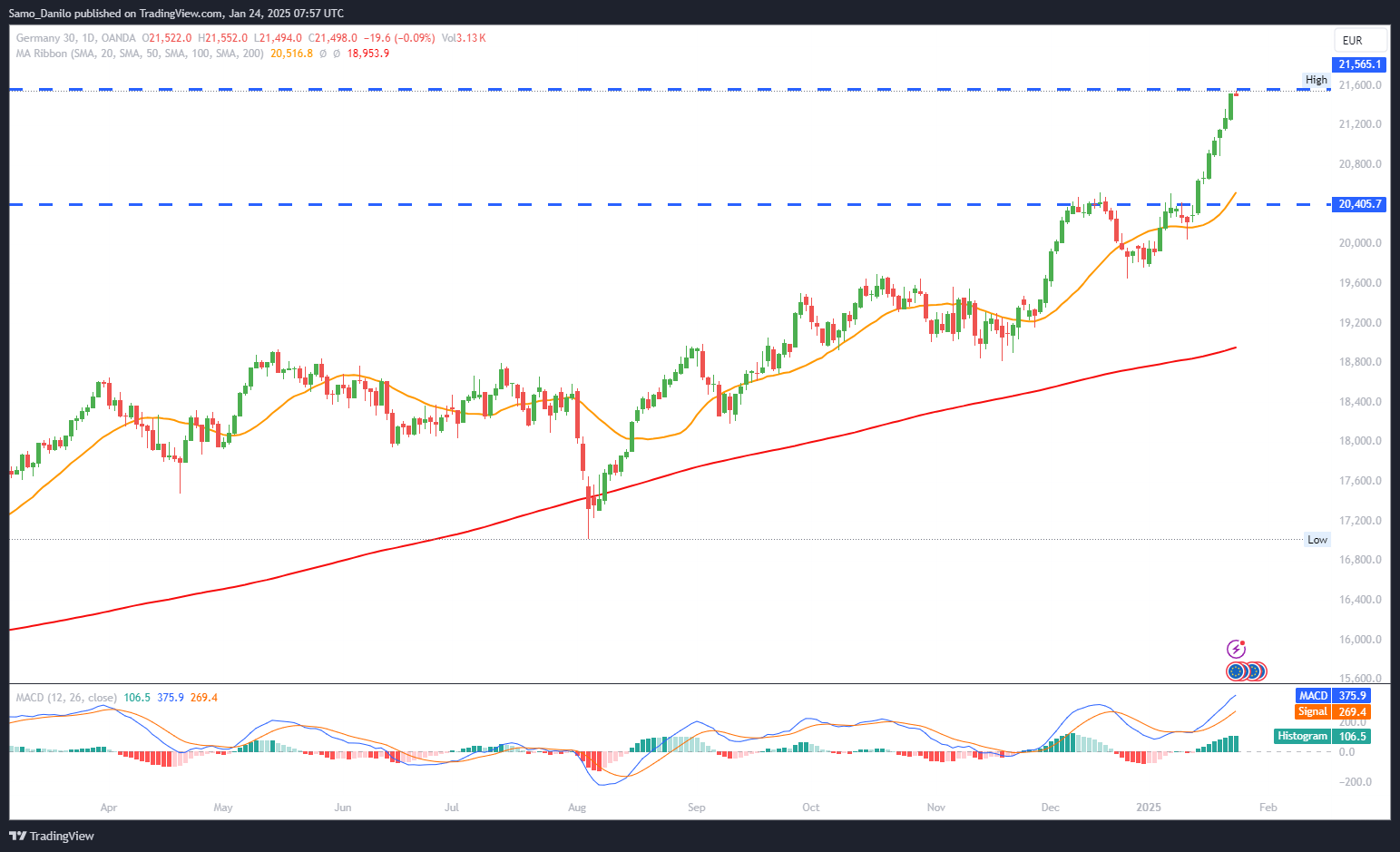EURUSD
- EUR/USD Price: The EUR/USD pair trades near 1.0450 in the early European session on Friday, benefiting from renewed US Dollar weakness. Market sentiment favors the Euro as traders react to dovish comments from both the European Central Bank (ECB) and US policymakers.
- ECB Lagarde: ECB President Christine Lagarde reiterated that the central bank remains unconcerned about external inflation risks and will continue its gradual rate-cutting trajectory.
- ECB Vujcic: ECB policymaker Boris Vujcic echoed that market expectations for rate cuts are reasonable and inflation risks remain balanced.
- Trump’s Davos Comments: US President Donald Trump’s remarks at the World Economic Forum in Davos weighed on the USD. Trump advocated for immediate global interest rate cuts, further fueling expectations of a dovish monetary stance from the Federal Reserve and other central banks.
- PMI Data: The release of the preliminary HCOB Purchasing Managers Index (PMI) for January from Germany and the broader Eurozone later on Friday could influence Euro sentiment. On the US side, the flash S&P PMI will provide insight into the American economy and could impact the USD and EUR/USD dynamics.
Closing statement: EUR/USD trades on firm footing above 1.0450, supported by ECB commentary and USD weakness following Trump’s dovish remarks. Traders should focus on upcoming PMI releases for further direction, while technical indicators suggest potential for moderate upside in the near term.
GBPUSD
- GBP/USD Price: The GBP/USD pair builds on its upward momentum for a second consecutive day, hovering around 1.2400 during the European session on Friday. Renewed optimism surrounding dovish Federal Reserve (Fed) expectations and weaker US Dollar sentiment support the pair’s climb.
- Trump’s Remarks: At the World Economic Forum in Davos, US President Donald Trump pushed for immediate global rate cuts, citing declining oil prices and the need to stimulate growth.
- Fed Rate Cut: While traders expect the Fed to hold its policy rate at 4.25%-4.50% during its January meeting, Trump’s inflationary fiscal policies could limit the scope for multiple Fed rate reductions in 2024.
- UK Data: Despite recent gains, the Pound Sterling (GBP) remains weighed down by softer-than-expected UK inflation and retail sales data for December. Additionally, sluggish labor demand and modest GDP growth indicate challenges for the UK economy, potentially capping further upside for GBP/USD.
- PMI and Sentiment Data: Traders will closely monitor the preliminary S&P Global PMI releases for January from both the UK and the US for insights into economic conditions. Additionally, the US Michigan Consumer Sentiment Index could influence the USD and GBP/USD dynamics later in the day.
Closing statement: GBP/USD trades near 1.2400, supported by US Dollar weakness and dovish Fed expectations. However, headwinds from weak UK economic data and resistance near 1.2450 could limit upside potential. Key PMI and consumer sentiment data will guide traders in determining the pair’s near-term direction.
XAUUSD
- Gold Price: The Gold price continues to climb on Friday, sustaining a strong uptrend established over the past month. Worries about a fresh wave of global trade wars underpin the safe-haven metal.
- Trump's Announcements: Earlier in the week, Trump announced plans to impose tariffs on imports from Canada, Mexico, China, and the European Union on February 1. However, no further clarity has been provided, leaving investors flocking to safety in the bright meta
- Trump and Interest Rates: In his World Economic Forum (WEF) address, Trump called for a weaker US Dollar (USD) and lower global interest rates. This sentiment exerted downward pressure on the USD, bolstering demand for non-yielding assets such as gold.
- BoJ rate cut: Expectations of a hawkish rate hike from the Bank of Japan (BoJ) pose a risk to the USD/JPY, which could further weaken the USD. Such developments would likely support additional upside in gold prices as investors seek refuge in the bright metal amid broader currency volatility.
- Economic Data: Gold traders are focused on the release of preliminary Manufacturing and Services PMI data for January from major economies. These reports are expected to provide fresh perspectives on global economic growth, influencing the near-term outlook for the gold market.
Closing statement: Gold continues to gain traction, driven by trade war fears and USD weakness following Trump's remarks. Upcoming PMI data and potential BoJ action will likely shape short-term price movements. The metal is well-positioned to maintain its bullish momentum, with resistance levels within reach if safe-haven demand persists.
CRUDE OIL
- WTI Price: West Texas Intermediate (WTI) crude oil prices have paused their six-day losing streak, trading near $74.50 per barrel during European hours on Friday. This recovery comes amid traders reassessing recent downward momentum, although the weekly trend remains negative.
- Trump’s Production Plan: Oil prices are under pressure as US President Donald Trump announced an aggressive plan to increase domestic oil production. Trump also urged OPEC to lower crude prices, raising concerns about potential oversupply in global markets.
- US EIA Report: The Energy Information Administration (EIA) revealed a reduction of 1.017 million barrels in US crude oil stockpiles for the week ending January 17. While the inventory draw signals slightly tighter domestic supply, it has not been enough to offset bearish sentiment stemming from increased production plans.
- China Trade Tariff: Oil demand received a boost after Trump suggested he might avoid imposing additional tariffs on China, the world’s largest oil importer. This optimism around US-China trade relations has provided a temporary lift to oil prices.
- PMI and Policy Developments: Oil traders will closely monitor Friday's preliminary US S&P Global PMI data for January to gauge economic activity and its potential impact on oil demand. Additionally, developments regarding Trump’s production and OPEC-related policies will remain key drivers for crude prices.
Closing statement: Crude oil prices have stabilized near $74.50 per barrel, rebounding from recent losses. However, bearish pressures from Trump’s production plan and concerns over oversupply persist. Traders will watch upcoming PMI data and policy announcements for further directional cues. Resistance near $76.00 and support at $72.50 may define short-term price action.
DAX
- DAX Price: The DAX continued its impressive performance, rallying 0.74% on Thursday after a 0.25% gain on Wednesday to close at a record high of 21,412. The index’s seven-session winning streak highlights its resilience despite persistent global uncertainties, particularly around trade and economic policy.
- Sector Highlights: Siemens Energy AG was a standout performer, surging 6.27%, while Fresenius Medical Care posted an impressive 4.91% gain, driven by optimism in the healthcare sector. Auto stocks showed mixed performance due to tariff uncertainties, with Volkswagen climbing 1.66% while BMW fell 1.07%.
- Eurozone Consumer Confidence: The Consumer Confidence Index for the Eurozone improved slightly in January, rising to -14.2 from December’s -14.5. However, the index remains below its long-term average, reflecting lingering economic concerns across the region.
- Key Data: Preliminary private sector PMI numbers for Germany and the Eurozone, scheduled for Friday, could shape near-term sentiment. Economists expect Germany’s HCOB Services PMI to dip slightly to 51.0 from December’s 51.2, with the manufacturing sector projected to remain in contraction. Similar trends are anticipated for Eurozone PMIs, signaling a challenging growth environment.
- US Jobless Claims: US initial jobless claims rose to 223,000 for the week ending January 18, up from 217,000 the prior week. This upward trend may increase expectations for a dovish Federal Reserve rate policy, as a softer labor market could curb wage growth and consumer spending, indirectly supporting equity markets like the DAX.
Closing statement: The DAX remains in an upward trajectory, supported by gains in key sectors like energy and healthcare. However, upcoming PMI data for Germany and the Eurozone, coupled with evolving US labor market dynamics, will likely influence near-term market sentiment. Resistance at 21,500 and support near 21,000 may define the next trading range.
